Biography
James Ford was born in Perth Amboy, New Jersey. He moved to New York City in 1797 and to Lindsley Town (later Lindley, New York) in 1803. He moved to Tioga County, Pennsylvania, and was elected a member of the Pennsylvania House of Representatives in 1824 and 1825.

Perth Amboy is a city in Middlesex County, New Jersey, United States. The City of Perth Amboy is part of the New York metropolitan area. As of the 2010 United States Census, the city's population was 50,814, reflecting an increase of 3,511 (+7.4%) from the 47,303 counted in the 2000 Census, which had in turn increased by 5,336 (+12.7%) from the 41,967 counted in the 1990 Census. Perth Amboy has a Hispanic majority population. In the 2010 census, persons of "Hispanic, Latino or Spanish origin" made up 78.1% of the population, second to Union City at 84.7%. Perth Amboy is known as the "City by the Bay," referring to Raritan Bay.

The City of New York, usually called either New York City (NYC) or simply New York (NY), is the most populous city in the United States. With an estimated 2017 population of 8,622,698 distributed over a land area of about 302.6 square miles (784 km2), New York is also the most densely populated major city in the United States. Located at the southern tip of the state of New York, the city is the center of the New York metropolitan area, the largest metropolitan area in the world by urban landmass and one of the world's most populous megacities, with an estimated 20,320,876 people in its 2017 Metropolitan Statistical Area and 23,876,155 residents in its Combined Statistical Area. A global power city, New York City has been described as the cultural, financial, and media capital of the world, and exerts a significant impact upon commerce, entertainment, research, technology, education, politics, tourism, art, fashion, and sports. The city's fast pace has inspired the term New York minute. Home to the headquarters of the United Nations, New York is an important center for international diplomacy.

Lindley is a town in southern Steuben County, New York, United States. The population was 1,913 at the 2000 census. The town was named after the early settler Eleazer Lindsley.
Ford was elected as a Jacksonian to the Twenty-first and Twenty-second Congresses. He operated a sawmill and a gristmill at Lawrenceville, Pennsylvania, until his death at that place in 1859. Interment in the old Lindsley family cemetery at Lindley, New York.

The Twenty-first United States Congress was a meeting of the legislative branch of the United States federal government, consisting of the United States Senate and the United States House of Representatives. It met in Washington, D.C. from March 4, 1829, to March 4, 1831, during the first two years of Andrew Jackson's presidency. The apportionment of seats in the House of Representatives was based on the Fourth Census of the United States in 1820. Both chambers had a Jacksonian majority.

The Twenty-second United States Congress was a meeting of the legislative branch of the United States federal government, consisting of the United States Senate and the United States House of Representatives. It met in Washington, D.C. from March 4, 1831, to March 4, 1833, during the third and fourth years of Andrew Jackson's presidency. The apportionment of seats in the House of Representatives was based on the Fourth Census of the United States in 1820. Both chambers had a Jacksonian majority.

Lawrenceville is a borough in Tioga County, Pennsylvania, in the United States. The population was 627 at the 2000 census.
The James Ford House is a house he had built for his son in 1831. It was listed on the National Register of Historic Places in 1975. [1]
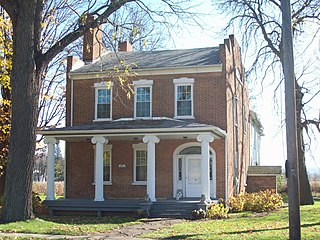
James Ford House is a historic home located at Lawrenceville in Tioga County, Pennsylvania. It is a 2 1⁄2-story brick house built in 1831 in the late Federal style. Congressman James Ford had this house built for his son.

The National Register of Historic Places (NRHP) is the United States federal government's official list of districts, sites, buildings, structures, and objects deemed worthy of preservation for their historical significance. A property listed in the National Register, or located within a National Register Historic District, may qualify for tax incentives derived from the total value of expenses incurred preserving the property.
This page is based on this
Wikipedia article Text is available under the
CC BY-SA 4.0 license; additional terms may apply.
Images, videos and audio are available under their respective licenses.
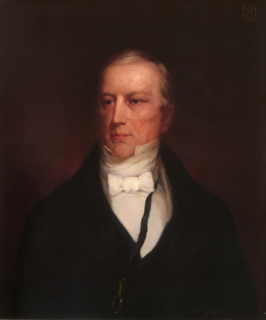
Andrew Stevenson was a Democratic politician in the United States. He served in the United States House of Representatives representing Virginia, as Speaker of the House, and as Minister to the United Kingdom.
Benedict Arnold was an American politician from New York, and a member of the House of Representatives.

Thomas Stalker Butler was a U.S. Representative born in Pennsylvania, serving from March 4, 1897 until his death, having been elected to the House sixteen times. Thomas S. Butler was also the father of the famous Marine Corps General Smedley D. Butler.
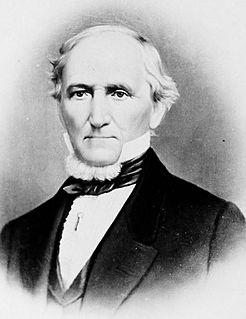
John Magee was a member of the United States House of Representatives from New York (1827–1831).

Oliver Hampton Smith was a United States Representative and Senator from Indiana. Born on Smith's Island, near Trenton, New Jersey, he attended the common schools and moved west, eventually settling in Lawrenceburg, Indiana in 1818. He studied law and was admitted to the bar in 1820, commencing practice in Connersville. From 1822 to 1824 he was a member of the Indiana House of Representatives and was prosecuting attorney for the third judicial district, 1824-1825.

John Lowndes McLaurin was a United States Representative and Senator from South Carolina; born in Red Bluff, South Carolina, he attended schools at Bennettsville, South Carolina and Englewood, New Jersey as well as Bethel Military Academy and Swarthmore College He graduated from the Carolina Military Institute, studied law in the University of Virginia at Charlottesville, was admitted to the bar in 1883 and practiced in Bennettsville. He was a member of the South Carolina House of Representatives in 1890-1891 and was attorney general of the State from 1891 to 1897.

Hiland Hall was an American lawyer and politician who served as Governor of Vermont and a United States Representative.
James Black was a Jacksonian and Democratic member of the U.S. House of Representatives from Pennsylvania.
John Gilmore was a Jacksonian member of the U.S. House of Representatives from Pennsylvania.
George Burd was an Anti-Jacksonian member of the U.S. House of Representatives from Pennsylvania.
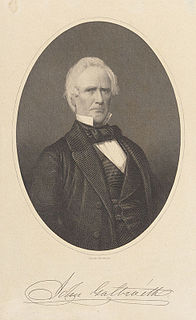
John Galbraith was a Jacksonian and Democratic member of the U.S. House of Representatives from Pennsylvania.

Joseph Hemphill was an American politician who served as a Federalist member of the U.S. House of Representatives for Pennsylvania's 3rd congressional district from 1801 to 1803 and from 1829 to 1831.
James S. Stevenson was a Jacksonian member of the U.S. House of Representatives from Pennsylvania.

Willis Allen was a U.S. Representative from Illinois, and the father of William J. Allen.
Amos Lane was a U.S. Representative from Indiana, father of James Henry Lane.
John Dickson was a U.S. Representative from New York.

Porter Sheldon was an American politician and a U.S. Representative from New York.
Samuel Gilbert Hathaway was a U.S. Representative from New York.
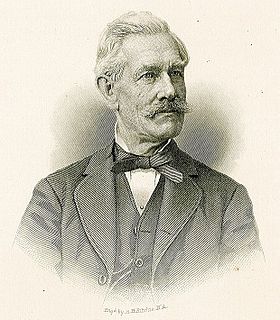
James Girard Lindsley was an American politician and a U.S. Representative from New York.
John Heritage Bryan was a U.S. Representative from North Carolina.


















